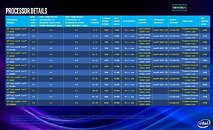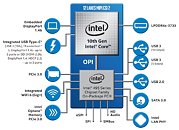Wednesday, July 10th 2019

Intel 10th Generation Core "Comet Lake" Lineup Detailed
Intel's short-term reaction to AMD's 3rd generation Ryzen processor family is the 10th generation Core "Comet Lake." These processors are based on existing "Skylake" cores, but have core-counts increased at the top-end, and HyperThreading enabled across the entire lineup. The Core i3 series are now 4-core/8-thread; the Core i5 series a 6-core/12-thread, the Core i7 series are 8-core/16-thread, and the new Core i9 series are 10-core/20-thread. Besides core-counts, Intel has given its 14 nanometer node one last step of refinement to come up with the new 14 nm+++ nodelet. This enables Intel to significantly dial up clock speeds across the board. These processors come in the new LGA1159 package, and are not backwards-compatible with LGA1151 motherboards. These chips also appear to feature an on-package PCH, instead of chipset on the motherboard.
Leading the pack is the Core i9-10900KF, a 10-core/20-thread chip clocked at 4.60 GHz with 5.20 GHz Turbo Boost, 20 MB of shared L3 cache, native support for DDR4-3200, and a TDP of 105 W. Intel's new 10-core die appears to physically lack an iGPU, since none of the other Core i9 10-core models offer integrated graphics. For this reason, all three processor models have the "F" brand extension denoting lack of integrated graphics. The i9-10900KF is closely followed by the i9-10900F clocked at 4.40/5.20 GHz, the lack of an unlocked multiplier, and 95 W TDP rating. The most affordable 10-core part is the i9-10800F, clocked at 4.20 GHz with 5.00 GHz boost, and a TDP of just 65 W. Intel has set ambitious prices for these chips. The i9-10900KF is priced at $499, followed by the i9-10900F at $449, and the i9-10800F at $409.The 10th generation Core i7 series, as we mentioned, consist of 8-core/16-thread processors. These are physically the same die found on the i9-9900K, but built on the new 14 nm+++ nodelet, and benefit from higher clock speeds. The Core i7-10700K clocked at 4.80 GHz with 5.10 GHz boost, offers 16 MB of shared L3 cache, Intel Gen9.5-based UHD 730 graphics, and native support for DDR4-3200. Intel is pricing the i7-10700K at $389. This is closely followed by the $339 Core i7-10700, which lacks an unlocked multiplier, ticks at 4.60 GHz with 4.90 GHz boost, and comes with a 65 W TDP.
The 10th generation Core i5 family consist of 6-core/12-thread processors, which are physically similar to the Core i7-8700K, but fabbed on 14 nm+++. The Core i5-10600K offers an unlocked multiplier, clock speeds of 4.70 GHz with 4.90 GHz boost, 12 MB of shared L3 cache, 95 W TDP, UHD 730 graphics, and native support for DDR4-3200 memory. This chip is priced at $269. It is closely followed by the i5-10600 clocked at 4.60 GHz with 4.80 GHz boost, the lack of an unlocked multiplier, and a $229 price-tag. Other Core i5 SKUs include the i5-10500 (4.40-4.50 GHz, $199 price), and i5-10400 (4.20-4.40 GHz, $179 price).
At the bottom of the pile is the new Core i3 family of 4-core/8-thread chips, which is surprisingly not physically simlar to the quad-core "Skylake" die, but is rather carved out from the 6-core silicon to give it 9 MB of shared L3 cache. The Core i3-10350K is price-matched with the i5-10400 at $179, offers an unlocked multiplier, and is clocked at 4.60 GHz with 4.80 GHz boost, with a 95 W TDP. It's trailed by the i3-10320 (4.50-4.70 GHz, 9 MB L3 cache, $159 price); and the i3-10300 (4.30-4.50 GHz, 9 MB L3 cache, and $149 price). At the very bottom is the Core i3-10100. This 4-core/8-thread chip is configured with just 7 MB of L3 cache, 4.20-4.40 GHz clock-speeds, 65 W TDP, and a $129 price.
The 10th generation Panic Lake lacks PCIe gen 4.0, uses 32 Gbps DMI 3.0 chipset bus, and will be accompanied by the new 495-series chipset that sits on the same package as the CPU die, and talks to it over OPI, which is basically on-package DMI (32 Gbps). The CPU socket now puts out all of the platform connectivity on the motherboard. Among the connectivity options are one PCI-Express 3.0 x16 link meant for graphics, a handful USB 3.1 gen 2 and gen 1 ports, a few M.2 PCIe 3.0 x4 slots, SATA 6 Gbps ports, HDA bus, and GbE PHY.
There's no information on when the 10th generation "Comet Lake" launches, but something tells us Intel will frantcally launch this platform to cut into 3rd gen Ryzen sales, because its desktop "Ice Lake" processor won't launch before 2020.
Source:
WCCFTech
Leading the pack is the Core i9-10900KF, a 10-core/20-thread chip clocked at 4.60 GHz with 5.20 GHz Turbo Boost, 20 MB of shared L3 cache, native support for DDR4-3200, and a TDP of 105 W. Intel's new 10-core die appears to physically lack an iGPU, since none of the other Core i9 10-core models offer integrated graphics. For this reason, all three processor models have the "F" brand extension denoting lack of integrated graphics. The i9-10900KF is closely followed by the i9-10900F clocked at 4.40/5.20 GHz, the lack of an unlocked multiplier, and 95 W TDP rating. The most affordable 10-core part is the i9-10800F, clocked at 4.20 GHz with 5.00 GHz boost, and a TDP of just 65 W. Intel has set ambitious prices for these chips. The i9-10900KF is priced at $499, followed by the i9-10900F at $449, and the i9-10800F at $409.The 10th generation Core i7 series, as we mentioned, consist of 8-core/16-thread processors. These are physically the same die found on the i9-9900K, but built on the new 14 nm+++ nodelet, and benefit from higher clock speeds. The Core i7-10700K clocked at 4.80 GHz with 5.10 GHz boost, offers 16 MB of shared L3 cache, Intel Gen9.5-based UHD 730 graphics, and native support for DDR4-3200. Intel is pricing the i7-10700K at $389. This is closely followed by the $339 Core i7-10700, which lacks an unlocked multiplier, ticks at 4.60 GHz with 4.90 GHz boost, and comes with a 65 W TDP.
The 10th generation Core i5 family consist of 6-core/12-thread processors, which are physically similar to the Core i7-8700K, but fabbed on 14 nm+++. The Core i5-10600K offers an unlocked multiplier, clock speeds of 4.70 GHz with 4.90 GHz boost, 12 MB of shared L3 cache, 95 W TDP, UHD 730 graphics, and native support for DDR4-3200 memory. This chip is priced at $269. It is closely followed by the i5-10600 clocked at 4.60 GHz with 4.80 GHz boost, the lack of an unlocked multiplier, and a $229 price-tag. Other Core i5 SKUs include the i5-10500 (4.40-4.50 GHz, $199 price), and i5-10400 (4.20-4.40 GHz, $179 price).
At the bottom of the pile is the new Core i3 family of 4-core/8-thread chips, which is surprisingly not physically simlar to the quad-core "Skylake" die, but is rather carved out from the 6-core silicon to give it 9 MB of shared L3 cache. The Core i3-10350K is price-matched with the i5-10400 at $179, offers an unlocked multiplier, and is clocked at 4.60 GHz with 4.80 GHz boost, with a 95 W TDP. It's trailed by the i3-10320 (4.50-4.70 GHz, 9 MB L3 cache, $159 price); and the i3-10300 (4.30-4.50 GHz, 9 MB L3 cache, and $149 price). At the very bottom is the Core i3-10100. This 4-core/8-thread chip is configured with just 7 MB of L3 cache, 4.20-4.40 GHz clock-speeds, 65 W TDP, and a $129 price.
The 10th generation Panic Lake lacks PCIe gen 4.0, uses 32 Gbps DMI 3.0 chipset bus, and will be accompanied by the new 495-series chipset that sits on the same package as the CPU die, and talks to it over OPI, which is basically on-package DMI (32 Gbps). The CPU socket now puts out all of the platform connectivity on the motherboard. Among the connectivity options are one PCI-Express 3.0 x16 link meant for graphics, a handful USB 3.1 gen 2 and gen 1 ports, a few M.2 PCIe 3.0 x4 slots, SATA 6 Gbps ports, HDA bus, and GbE PHY.
There's no information on when the 10th generation "Comet Lake" launches, but something tells us Intel will frantcally launch this platform to cut into 3rd gen Ryzen sales, because its desktop "Ice Lake" processor won't launch before 2020.


128 Comments on Intel 10th Generation Core "Comet Lake" Lineup Detailed
Socket details are correct though, from what I know.
$ sign as mentioned, some of the layout is weird, Intel does not usually use 14++ notation on these slides, maximum all-core turbo is not a thing Intel has mentioned in a while (if ever).
- the $ sign a the end of the pricing figures
- Source: WCCFTech
We have to stop recycling their garbage, this is TPU.Edit: another proof it's fake: Intel always adds small number on mem speed so you need to go and read the FOOTNOTES.
Not so seriously, but all these jokes about Intel's 14nm and nobody thought about 14nm# yet?
I think im waiting for the i-something 110110 though.
i3 now has 4 cores and 8 threads :) for the same or less money as the 2 cores 4 threads intel pushed on its customers for like 7 years, until 8100 which came with 4 real cores.
Now they've stepped up the lower end even more.
For this reason alone and AMD should be supported.
Already been determined this was fake anyway and the prices are just too "Low" for the parts shown in my view of it.
Did intet just find 50% power savings on same node? Lol.
May be think a little before posting? That should have hit you in the face.
Intel ceo: Gentlemen we need to proceed to 10 nm now and get the marked back from amd. We are ready to do it.
Intel worker to intel ceo: eh we still have problems with 10 nm, we are only ready for laptops now and servers next year. Maybe in 2021 for desktop or at least 2022. But dont worry, we have panic lake...on 14 nm+++++. We have added 2 more panic cores, higher boost clock in panic to amd better ipc and we now call it panic boost, we will set tdp low and not tell about real world power usage or how hot they will run. It would look great on paper.
Intel ceo to worker: :slap:
Also intel ceo: lest leak some slides for now...
Just blacklist wccftech and never use that swamp as a source even again.
Dont Think this is Real as We soon see 9900KS